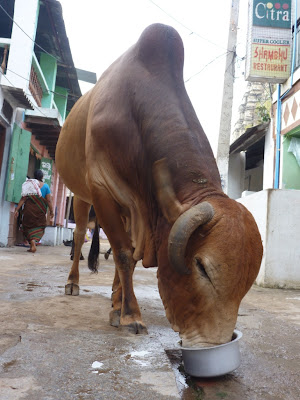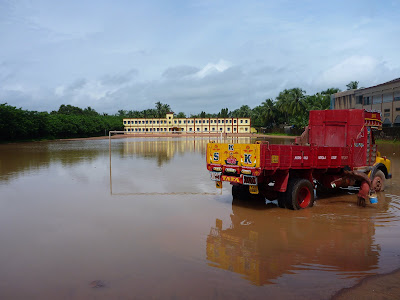Not much to say on the de-husker front this week unfortunately. Both workshops are working away and will hopefully each have something for me to try out before I leave. Most of my time has been spent designing the next prototype of the de-husker we showed to the farmers and also an automatic fire feeder. I’ve had quite a few ideas while I’ve been here of how the de-husker project can develop beyond what I’ve had time to do, and so it would be nice to try to follow through with them once back in the UK. I’ve had a couple of talks with the head of the mechanical engineering department here and he seems keen to coordinate things with the workshops and test the next prototypes so I’m really hopeful that it’s going to work out.
The fire feeder is intended to provide a cheap, automatic way of feeding small pieces of firewood or waste such as coconut husks into a fire without someone needing to attend it constantly. It’s a project which SELCO had previously considered but were unsure how useful it would actually be to people. Hopefully this prototype will work well enough to get a better idea.
The swinging pendulum controls the rate of feeding in a similar way to the mechanism in a grandfather clock.
I also paid another visit to SIRI in the week (see this blog posting) to show them the ideas I’d had for the improved leaf plates and the incense stick making device, and they seemed keen on both. It was very satisfying to see some of the staff get quite excited as more and more people gradually got called into the office. I’d managed to get the plates stiffer and better shaped by drying them in a certain way, and they reckon they should be suitable for export now. They need to improve the cleaning method slightly but since the meeting I’ve had a look into how some other companies do it and it shouldn’t be too difficult. SIRI had previously been approached by a company who wanted containers with a lockable lid and so I’d had a bit of a play with that too and managed to come up with a locking device which works with the leaves. They also liked the machine I found to improve the bamboo splitting for the incense sticks and are going to contact the manufacturer to trial it. All in all it was a really encouraging meeting and I sort of feel that that alone makes my trip seem worthwhile.
On Wednesday and Thursday last week, we were visited by Jonathon, an American who’s recently set up a business called Biolight making improved cook-stoves (ones which produce less harmful smoke) with a thermoelectric device allowing the user to charge a phone or small light. He wanted our help with conducting its first trial with potential users. Our first visit was to a local woman who has a phone but no electricity. The test showed up a few things that needed improvement but on the whole it worked well, and the woman was very keen on the idea. We also took the stove to Dhamastala, a neighbouring town which attracts Hindu pilgrims from up to 300km away and so we had a chance to demo it to a broad audience. We had some good fun explaining how it works and giving out free cups of tea (or something equivalent), and I was amazed by how many people we attracted.
The Biolight stove being used next to a conventional three-stone stove
More interesting than an elephant
At the weekend, I took a bit of extra time off work to spend three days in Hampi. The ancient city used to be the capital of the Vijayanagara Empire which used to cover South India, and now consists of an overwhelming number of temples and bazaars stretched over 10 square kms.
I couldn’t get over the number of westerners though, and I actually felt a bit uncomfortable around them. Most of them were young globe-trotters on their gap yahs, although luckily the place is big enough that you can lose them all as you wander round the ancient monuments, and luckily too (and also pretty amazingly!) I bumped into Isabelle from the SAP visit the week before within 20 minutes of arriving. I think she had similar feelings about all the tourists and it was nice to spend much of the first day exploring the sites with her and her friend.
Despite the centre feeling a bit like a tourist attraction, the rest was amazing and I had a brilliant time there. The architecture was beautifully crafted and covered in elaborate carvings, and the scenery was absolutely breathtaking: impossible heaps of boulders perched precariously on the miles of undulating terrain, amid palm groves and paddy fields.
On the second day I met a guy at breakfast who seemed a bit more down to earth and I spent the rest of the day with him. Apparently, due to the size of the place, the best way to see everything is by motorbike and I felt very ‘Indiana Jones’ riding around the ancient temples. Unlike English heritage sites, you don’t need to dismount when you actually reach the attractions.
And a few more picks from the week:
These protected stone pillars are each tuned to play a different note and tone when tapped. For a bribe of only 50 rupees the security guard will play them for you, and from an engineering perspective they really are quite incredible.
This snake charmer was one of the ‘attractions’, along with guys dressed with red sheets and facepaint who would let you take their photo for a price. But to be honest, it was pretty cool.




























































